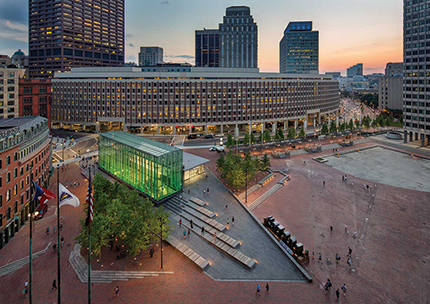

Boston, MA In collaboration with the City of Boston and the MBTA, landscape architects Halvorson Design Partnership and architect/engineer HDR, Inc. have taken the first steps towards revitalizing the Government Center Plaza.
A product of the late 1960s “urban renewal” program, the brutalist City Hall Plaza replaced what was once the lively commercial district of Scollay Sq. The plaza, often colloquially referred to as “the brick desert,” has been an underutilized mid-century space largely devoid of human activity. As useful as the plaza is for accommodating large crowds, it offered little in terms of other uses or drawing the community into the space on a day-to-day basis.
With the introduction of new gathering spaces and a variety of seating opportunities, the plaza now has daily visitors soaking up the sun or enjoying their lunch at bistro tables under the dappled shade of large canopy trees. Not only do these tree bosques help define the edges of the plaza and offer respite for residents, workers and tourists, there are a number of direct environmental benefits of the trees that will set the tone for a resilient future. The tree bosques reduce the heat island effect and are planted in an open jointed permeable paving system, increasing the life expectancy of the trees while maximizing stormwater infiltration on the plaza.
In addition to green infrastructure solutions, the improvements have made Government Center a true multi-model transportation hub with improved pedestrian and bicycle access via the new Government Center Station MBTA headhouse, bike share stations and electric vehicle charging stations. Most importantly, the existing terraced steps were replaced with sloped walks, resulting in universal access to Cambridge St., Government Center station and City Hall.
“We’re very excited to see this project finally come to fruition,” said Halvorson Design project manager, Bryan Jereb. “The activation of the plaza has been a priority for the City and Boston’s design community for quite some time. We are thrilled to have played a role in the transformation.”
